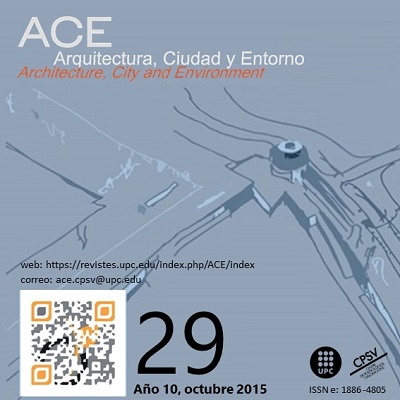"The vegetation in the microclimate comfort". Comparison of species of mediterranean climate of Barcelona, Spain
DOI:
https://doi.org/10.5821/ace.10.29.3589Keywords:
Mediterranean climate, urban vegetation, urban comfort, vegetation species.Abstract
It is well known that vegetation is an element that allows to reduce heat input to the microclimate, previous studies have explored how urban vegetation improve certain aspects. But they have not made many studies of the variability of the species based on comfort and microclimate. Each species has different characteristics, so their behavior and contributions to the microclimate are different, hence arises the need to know the variables, indicators and contributions of each species. The objective of this study is to analyze the quality of urban micro climate due to decreasing the amount of heat input by vegetation. To know in detail the characteristics of each tree species and make some technical specifications for use of urban design. With possible interpolation with other climates due to the variability of species in the city of Barcelona.
The methodology used was qualitative and quantitative. urban morphology and tree species were selected, the selection criteria used were the variability of species, the short distance between them allowing more versatility when in situ measurements, the high demand of users hosted this urban structure, guidance and variability of pavements with the same type of species. After selecting a study of these tree species thus creating form data sheets was performed. an analysis of observation of the busiest urban structures of the area was performed. Measurements comfort parameters were performed. Qualitative results were: Woodland features, bioclimatic diversity of species, different kinds of shadows formed by branches and tree species. And quantitative were: internal / external differences in the tree canopy radiant temperature (from now on Tr), luminance (from now on L) and illuminance (from now on E), little change in the air temperature (from now on Ta) and significant variations in relative humidity (from now on HR) during the day. Resulting qualitative values of the benefits of tree species, quality improvement in urban structure because of the amount of difference of thermal input and the recommendation of the use of urban concrete pavement with grass. The conclusions of how vegetation were able to create urban comfort and at what levels.
Downloads
Published
Issue
Section
License
| INTELECTUAL PROTECTION CRITERIA |
At this moment, it is count with the "Oficina Española de Patentes y Marcas", while global protection it is being processed by the World Intelectual Property Organization (OMPI/WIPO). Nevertheless the International Standard Serial Number Office (ISSN) has given the following numbers ISSN: 1886-4805 (electronic version) and 1887-7052 (paper version). All articles will be peer reviewed, using double blind reviewing. |
| COPYRIGHT |
The article contents and their comments are authors exclusive liability, and do not reflect necessarily the journal editor commitee's opinion. All ACE published works are subject to the following licence CC BY-NC-ND 3.0 ES http://creativecommons.org/licenses/by-nc-nd/3.0/es/ It implies that authors do not hold nor retain the copyright without restrictions but only those included in the licence. |





































